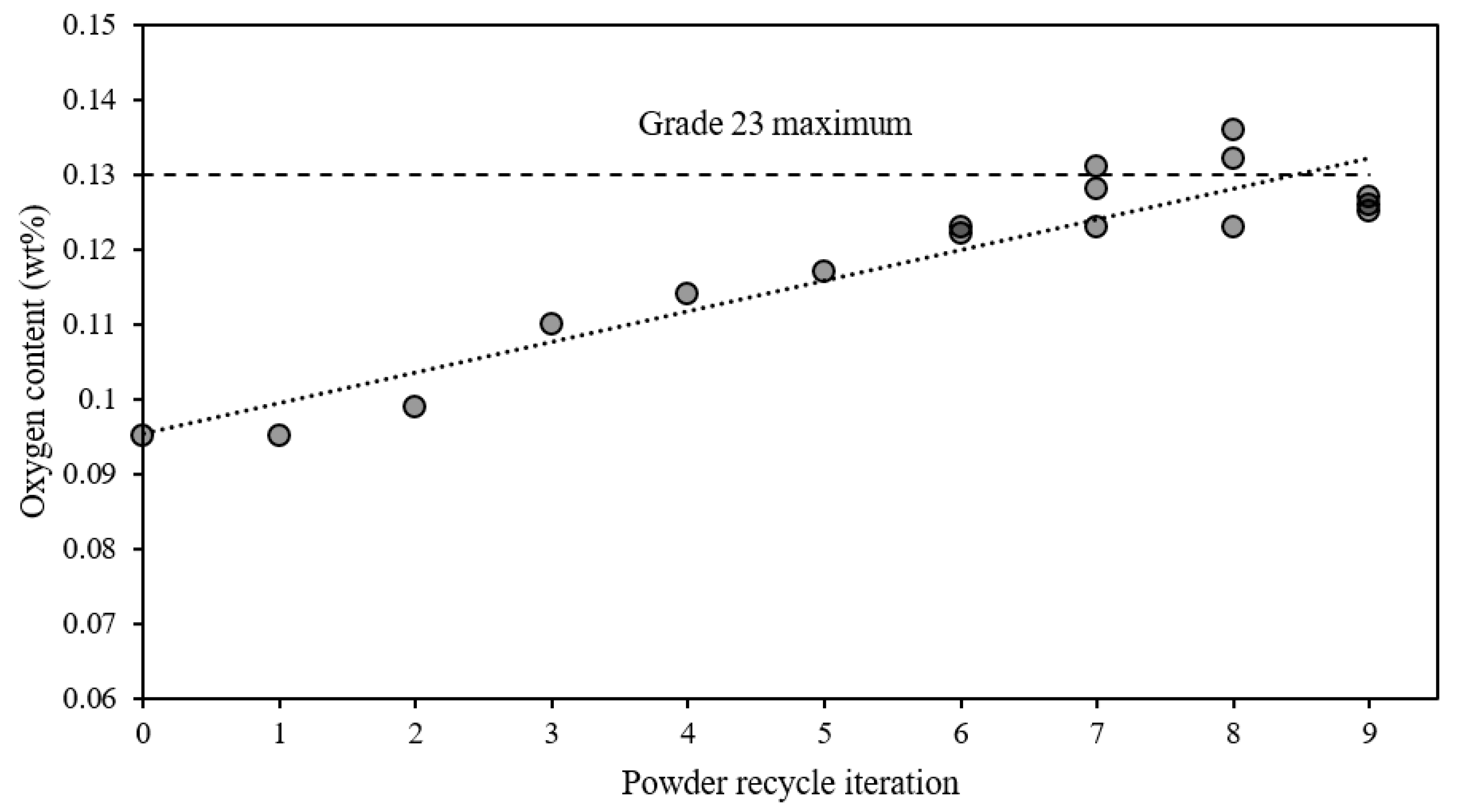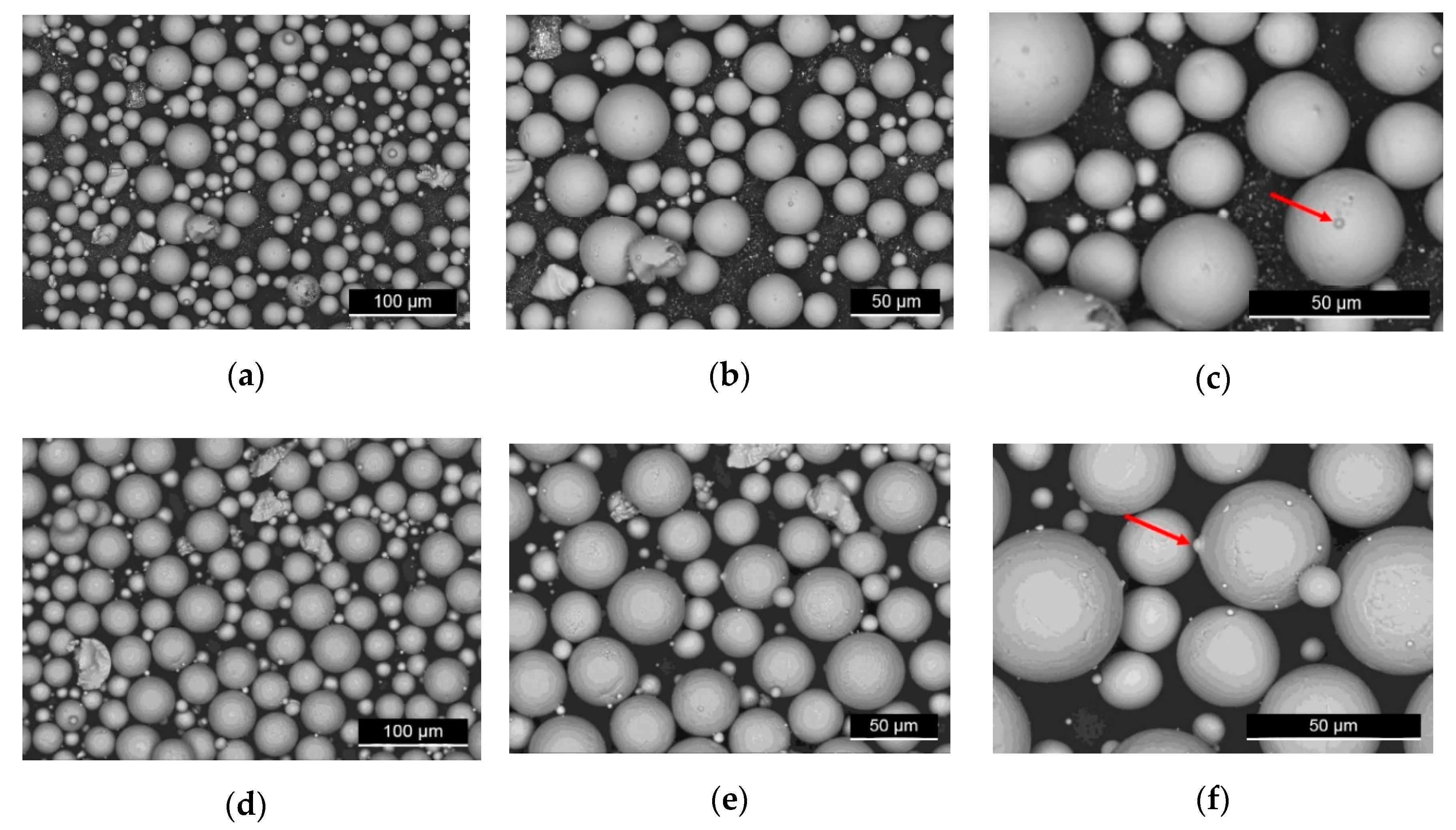Reuse of Grade 23 Ti6Al4V Powder during the Laser-Based Powder Bed Fusion Process
Abstract
1. Introduction
Aims and Objectives
- Tracking of the levels of interstitial elements O, N and H (wt%) at each build stage during the top-up regime.
- Monitoring and recording of the PSD and particle morphology.
- The evaluation of the impact of recycling on the flowability of the powder.
- Critical evaluation of the present findings to those found elsewhere in literature.
2. Materials and Methods
2.1. Process Parameters
2.2. Component Geometry
2.3. Feedstock Powder
2.4. Preparation of Control Pot
2.5. Powder Recycling
2.6. Powder Characterisation
3. Results
3.1. Chemical Compositional Analysis
3.2. Sizing—Particle Size Distribution
3.3. Bulk Morphology
3.4. Flowability
4. Discussion
5. Conclusions
Author Contributions
Funding
Acknowledgments
Conflicts of Interest
References
- Santecchia, E.; Spigarelli, S.; Cabibbo, M. Material Reuse in Laser Powder Bed Fusion: Side Effects of the Laser—Metal Powder Interaction. Metals 2020, 10, 341. [Google Scholar] [CrossRef]
- Kazantseva, N.; Krakhmalev, P.; Yadroitsev, I.; Fefelov, A.; Merkushev, A.; Ilyinikh, M.; Vinogradova, N.; Ezhov, I.; Kurennykh, T. Oxygen and nitrogen concentrations in the Ti-6Al-4V alloy manufactured by direct metal laser sintering (DMLS) process. Mater. Lett. 2017, 209, 311–314. [Google Scholar] [CrossRef]
- Sun, Y.; Aindow, M.; Hebert, R.J. Comparison of virgin Ti-6Al-4V powders for additive manufacturing. Addit. Manuf. 2018, 21, 544–555. [Google Scholar] [CrossRef]
- Thejane, K.; Chikosha, S.; Du Preez, W. Characterisation and Monitoring of Ti6Al4V (Eli) Powder Used in Different Selective Laser Melting Systems. S. Afr. J. Ind. Eng. 2017, 28, 161–171. [Google Scholar] [CrossRef]
- Dawes, B.J.; Bowerman, R. Introduction to the Additive Manufacturing Powder Metallurgy Supply Chain: Exploring the production and supply of metal powders for AM processes. Technol. Rev. 2015, 59, 243–256. [Google Scholar] [CrossRef]
- Spierings, A.B.; Voegtlin, M.; Bauer, T.; Wegener, K. Powder flowability characterisation methodology for powder-bed-based metal additive manufacturing. Prog. Addit. Manuf. 2015, 1, 9–20. [Google Scholar] [CrossRef]
- Sun, P.; Fang, Z.Z.; Zhang, Y.; Xia, Y. Review of the Methods for Production of Spherical Ti and Ti Alloy Powder. JOM 2017, 69, 1853–1860. [Google Scholar] [CrossRef]
- Debroy, T.; Wei, H.; Zuback, J.; Mukherjee, T.; Elmer, J.; Milewski, J.; Beese, A.; Wilson-Heid, A.; De, A.; Zhang, W. Progress in Materials Science Additive manufacturing of metallic components–Process, structure and properties. Prog. Mater. Sci. 2018, 92, 112–224. [Google Scholar] [CrossRef]
- Tang, H.P.; Qian, M.; Liu, N.; Zhang, X.Z.; Yang, G.Y.; Wang, J. Effect of Powder Reuse Times on Additive Manufacturing of Ti-6Al-4V by Selective Electron Beam Melting. JOM 2015, 67, 555–563. [Google Scholar] [CrossRef]
- Cordova, L.; Campos, M.; Tinga, T. Revealing the Effects of Powder Reuse for Selective Laser Melting by Powder Characterization. JOM 2019, 71, 1062–1072. [Google Scholar] [CrossRef]
- Del Re, F.; Contaldi, V.; Astarita, A.; Palumbo, B.; Squillace, A.; Corrado, P.; Di Petta, P. Statistical approach for assessing the effect of powder reuse on the final quality of AlSi10Mg parts produced by laser powder bed fusion additive manufacturing. Int. J. Adv. Manuf. Technol. 2018, 97, 2231–2240. [Google Scholar] [CrossRef]
- Rousseau, J.N.; Bois-Brochu, A.; Blais, C. Effect of oxygen content in new and reused powder on microstructural and mechanical properties of Ti6Al4V parts produced by directed energy deposition. Addit. Manuf. 2018, 23, 197–205. [Google Scholar] [CrossRef]
- Carrion, P.E.; Soltani-Tehrani, A.; Phan, N.; Shamsaei, N. Powder Recycling Effects on the Tensile and Fatigue Behavior of Additively Manufactured Ti-6Al-4V Parts. JOM 2019, 71, 963–973. [Google Scholar] [CrossRef]
- Quintana, O.A.; Alvarez, J.; McMillan, R.; Tong, W.; Tomonto, C. Effects of Reusing Ti-6Al-4V Powder in a Selective Laser Melting Additive System Operated in an Industrial Setting. JOM 2018, 70, 1863–1869. [Google Scholar] [CrossRef]
- Sutton, A.T.; Kriewall, C.S.; Karnati, S.; Leu, M.C.; Newkirk, J.W. Characterization of AISI 304L stainless steel powder recycled in the laser powder-bed fusion process. Addit. Manuf. 2020, 32, 100981. [Google Scholar] [CrossRef]
- Powell, D.; Rennie, A.E.W.; Geekie, L.; Burns, N. Understanding powder degradation in metal additive manufacturing to allow the upcycling of recycled powders. J. Clean. Prod. 2020, 268, 122077. [Google Scholar] [CrossRef]
- Denti, L.; Sola, A.; Defanti, S.; Sciancalepore, C.; Bondioli, F. Effect of Powder Recycling in Laser-based Powder Bed Fusion of Ti-6Al-4V. Manuf. Technol. 2019, 19, 190–196. [Google Scholar] [CrossRef]
- Seyda, V.; Kaufmann, N.; Emmelmann, C. Investigation of Aging Processes of Ti-6Al-4V Powder Material in Laser Investigation of aging processes of Ti-6Al-4V powder material in laser melting. Phys. Procedia 2012, 39, 425–431. [Google Scholar] [CrossRef]
- Park, S.B.; Road, B.; Kingdom, U. Investigating the effects of multiple re-use of Ti6Al4V powder in additive manufacturing. Renishaw PLC 2016, 1–10. [Google Scholar]
- Brika, S.E.; Letenneur, M.; Dion, C.A.; Brailovski, V. Influence of particle morphology and size distribution on the powder flowability and laser powder bed fusion manufacturability of Ti-6Al-4V alloy. Addit. Manuf. 2020, 31, 100929. [Google Scholar] [CrossRef]
- Obeidi, M.A.; Mussatto, A.; Groarke, R.; Vijayaraghavan, R.K.; Conway, A.; Kaschel, F.R.; McCarthy, E.; Clarkin, O.; O’Connor, R.; Brabazon, D. Comprehensive assessment of spatter material generated during selective laser melting of stainless steel, Mater. Today Commun. 2020, 25, 101294. [Google Scholar] [CrossRef]










| Reference | Recycling Strategy | Factors Investigated/Limitations | Reuse Times |
|---|---|---|---|
| Seyda et al. [18] | Single batch | PSD broadened, particles coarsened, flowability improved, compositional analysis not performed | 12 |
| Quintana et al. [14] | Single batch | PSD narrowed, oxygen content limit reached, flowability improved | 31 |
| Carrion et al. [13] | Single batch | PSD narrowed, flowability improved, oxygen and nitrogen increased, separate batches were utilised | 15 |
| Cordova et al. [10] | Single batch | No significant change to PSD, changes in oxygen content measured but within measurement uncertainty, flowability improved | 11 |
| Denti et al. [17] | Top-up | PSD narrowed, oxygen content increased (data was not provided), tests limited due to amount of powder available | 100 |
| Thejane et al. [4] | Single batch | Smaller particle sizes, spherical particles | 10 |
| Thejane et al. [4] | Top-up | PSD broadened with a shift towards a smaller particle sizes, spherical particles, potential for further recycles | 25 |
| Park et al. [19] | Single batch | PSD narrowed, 0.13 wt% oxygen content reach at 20th cycle, flowability improved | 38 |
| Cycle | 1 | 2 | 3 | 4 | 5 | 6 | 7 | 8 | 9 | 10 | 11 | 12 |
|---|---|---|---|---|---|---|---|---|---|---|---|---|
| Type | P | T | T | P | T | P | T | P | T | T | T | T |
| v/V | 0.01 | 0.05 | 0.05 | 0.04 | 0.05 | 0.09 | 0.05 | 0.06 | 0.05 | 0.05 | 0.05 | 0.05 |
| Characterisation Method | ASTM/ISO Standard | Test Method | Test Occurrence (Cycle) |
|---|---|---|---|
| Chemical composition | ISO 17025 | O, N and H analysis | 0–9 |
| Sizing | ASTM B822 | Laser size diffraction (volume and weighted number distribution) | 0–9 |
| Bulk morphology | - | SEM morphology imaging | 0, 3, 7 |
| Powder morphology | - | Quantitative shape analysis | 0, 3, 7 |
| Density | ASTM B212 | Apparent density | 0–9 |
| Density | ASTM B527 | Tap density | 0–9 |
| Flowability | ASTM B213 | Hall flow rate | 0–9 |
| Moisture | ASTM E1868 | Moisture content | 0, 3, 7 |
| Element | Al | V | Fe | C | O | N | H | Ti | Other | All Other |
|---|---|---|---|---|---|---|---|---|---|---|
| Grade 23 min | 5.5 | 3.5 | - | - | - | - | - | - | - | - |
| Grade 23 max | 6.5 | 4.5 | 0.25 | 0.03 | 0.13 | 0.03 | 0.012 | Bal | 0.1 | 0.4 |
| Master batch | 6.4 | 4 | 0.19 | 0.01 | 0.07 | 0.01 | 0.001 | Bal | <0.1 | <02 |
| Test pot | 6.5 | 4 | 0.19 | 0.02 | 0.11 | 0.01 | 0.003 | Bal | <0.1 | <0.2 |
| Control pot | - | - | - | - | 0.095 | 0.014 | 0.002 | - | - | - |
| Analysis | Cycle | |||||||||
|---|---|---|---|---|---|---|---|---|---|---|
| LSD | 0 | 1 | 2 | 3 | 4 | 5 | 6 | 7 | 8 | 9 |
| Dv10 | 22.3 | 21.8 | 22.2 | 21.6 | 21.8 | 21.6 | 21.9 | 22.1 | 21.8 | 22.5 |
| Dv50 | 33 | 32.4 | 32.6 | 32.2 | 32.4 | 32.2 | 32.4 | 32.6 | 32.1 | 33.1 |
| Dv90 | 48.3 | 47.6 | 47.4 | 47.3 | 47.7 | 47.5 | 47.2 | 47.6 | 46.8 | 48.2 |
| <14.5 µm | 0.06 | 0.09 | 0.05 | 0.12 | 0.09 | 0.13 | 0.07 | 0.05 | 0.08 | 0.03 |
| 14.5–45.6 µm | 86.34 | 87.38 | 87.67 | 87.84 | 87.31 | 87.5 | 88.04 | 87.45 | 88.52 | 86.51 |
| >45.6 µm | 13.6 | 12.53 | 12.28 | 12.04 | 12.6 | 12.37 | 11.89 | 12.50 | 11.40 | 13.46 |
| Analysis | Circularity | Convexity | Elongation | CE Diameter (µm) | Aspect Ratio | Solidity | ||||||
|---|---|---|---|---|---|---|---|---|---|---|---|---|
| Powder | Mean | RSD (%) | Mean | RSD (%) | Mean | RSD (%) | Mean | RSD (%) | Mean | RSD (%) | Mean | RSD (%) |
| Cycle 0 | 0.971 | 6.651 | 0.995 | 1.660 | 0.052 | 152.140 | 20.79 | 59.29 | 0.948 | 8.380 | 0.995 | 1.810 |
| Cycle 7 | 0.970 | 6.925 | 0.995 | 1.510 | 0.056 | 155.590 | 22.18 | 45.91 | 0.944 | 9.210 | 0.994 | 1.930 |
Publisher’s Note: MDPI stays neutral with regard to jurisdictional claims in published maps and institutional affiliations. |
© 2020 by the authors. Licensee MDPI, Basel, Switzerland. This article is an open access article distributed under the terms and conditions of the Creative Commons Attribution (CC BY) license (http://creativecommons.org/licenses/by/4.0/).
Share and Cite
Harkin, R.; Wu, H.; Nikam, S.; Quinn, J.; McFadden, S. Reuse of Grade 23 Ti6Al4V Powder during the Laser-Based Powder Bed Fusion Process. Metals 2020, 10, 1700. https://doi.org/10.3390/met10121700
Harkin R, Wu H, Nikam S, Quinn J, McFadden S. Reuse of Grade 23 Ti6Al4V Powder during the Laser-Based Powder Bed Fusion Process. Metals. 2020; 10(12):1700. https://doi.org/10.3390/met10121700
Chicago/Turabian StyleHarkin, Ryan, Hao Wu, Sagar Nikam, Justin Quinn, and Shaun McFadden. 2020. "Reuse of Grade 23 Ti6Al4V Powder during the Laser-Based Powder Bed Fusion Process" Metals 10, no. 12: 1700. https://doi.org/10.3390/met10121700
APA StyleHarkin, R., Wu, H., Nikam, S., Quinn, J., & McFadden, S. (2020). Reuse of Grade 23 Ti6Al4V Powder during the Laser-Based Powder Bed Fusion Process. Metals, 10(12), 1700. https://doi.org/10.3390/met10121700







